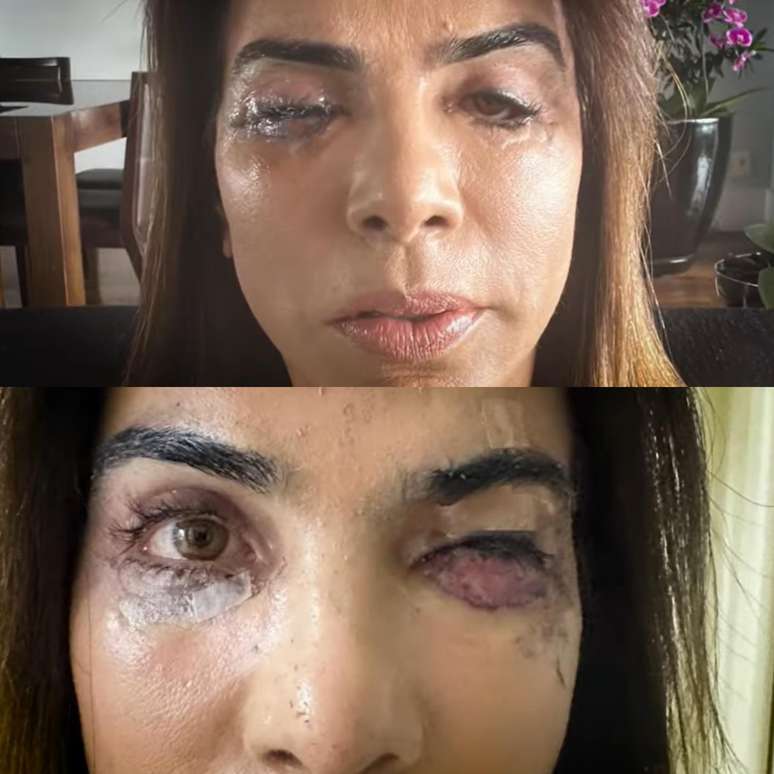Erika Alk, 49, had unexpected results and had to deal with a serious infection
Influencer Erika Alk, 49, faced a long and painful battle after complications caused by the use of PMMA (polymethyl methacrylate) in an aesthetic treatment performed 15 years ago. At the time, he turned to a doctor to treat his deep, pigmented dark circles, but the initial solution turned into a serious problem over the years.
In an emotional story, Erika shared how the situation has affected her personal and professional life. He described his life as having been completely disrupted by a series of complications, with his routine limited to requests medical and therapeutic sessions.
“I completely stopped my life. All I did was go to the doctor and come back,” he said in the documentary “Beyond Appearances,” available on YouTube.
There were four surgeries in a year, the first of which was to repair his eyes. However, the procedure had unexpected results and his eyelid “dropped off.” During this time, he faced a serious infection, which doctors initially did not identify as bacterial.
After seeing an ophthalmologist, it became clear that it was a bacterial infection and he had to begin hyperbaric treatment sessions to fight the bacteria and promote healing.

Despite the challenges, the sessions were effective, but Erika would still face further complications. Six months later, a second surgery made the situation worse, causing the eye to droop further.
It was at that moment that she asked for help from another doctor, who advised her to start new hyperbaric sessions, as she would have to undergo two more surgeries. Furthermore, the continuous use of antibiotics and corticosteroids significantly altered his health, especially that of his liver.
During this period of suffering, Erika was also at risk of losing her sight, as her eyes were constantly open and dry, which could lead to blindness.
“I couldn’t even look at myself in the mirror, it was an indescribable feeling. I have always been very vain, very worried about my appearance, but in that moment I looked at myself and didn’t recognize myself,” she said.
Despite all the suffering, the influencer found the strength to move forward and enhance aspects of his life. “We learn through pain. I learned a lot through pain, but I think it was necessary for my growth. I’m not complaining. If I can warn people about all this, I will do it with the greatest love in the world,” he said.
What is PMMA?
Polymethyl methacrylate, or PMMA, is a synthetic substance commonly used in medicine and dentistry for its strength and stability. However, its use in aesthetic procedures raises considerable concern and controversy, especially due to the risk of serious complications.
In aesthetics it is applied as a permanent filler to add volume to areas of the body and face. However, its presence in the body can generate several long-term complications.
“PMMA is not indicated for aesthetic fillers, except in very specific cases, such as to treat lipodystrophy in HIV/AIDS patients,” warns dermatologist Lucas Miranda, in an interview with Terra Você.
Why is PMMA risky?
The complications arising from the use of PMMA in aesthetics are multiple and can have serious consequences. According to the dermatologist, the use of PMMA carries significant risks, including inflammation, nodule formation, tissue necrosis, and even death due to serious complications, such as pulmonary embolism.
These reactions occur due to the permanence of the substance in the organism and the biological responses that the organism can develop against the material.
Biomedical scientist Thiago Martins explains that the physicochemical characteristics of PMMA can directly influence the biological reactions of the organism.
“The particle size, purity and chemical stability of PMMA are crucial factors to avoid adverse reactions. The impurities present in the material, for example, can intensify inflammatory processes or allergic reactions,” he explains to Terra Você.
Long-term complications and risks
One of the most common complications associated with the use of PMMA are granulomas, which are inflammatory nodules that can appear after the application of the material. According to Thiago, “the size of PMMA particles can impact the inflammatory response: smaller particles tend to be phagocytosed more easily, generating a more intense inflammatory reaction, while larger particles can reduce this response.”
Furthermore, the risk of product migration to other areas of the body is a real problem.
“The composition and consistency of PMMA also affects its ability to remain stable at the injection site. Low-quality or improperly applied products can migrate to adjacent areas, leading to unwanted cosmetic results and complications,” adds the biomedical scientist.
Safer alternatives
For those looking for aesthetic filling options, hyaluronic acid appears as a safer and expert-recommended alternative.
“Hyaluronic acid is biocompatible and offers a temporary effect, being reabsorbed by the body over time, minimizing risks and allowing for necessary adjustments,” says Miranda.
This type of temporary filler also allows for greater flexibility for changes and easier recovery, as the hyaluronic acid dissolves easily if dissatisfaction occurs.
In addition to the choice of material, the choice of a qualified and experienced professional is essential for patient safety.
“The professional must be able to perform the procedure, know the correct depth of the injection and the technique necessary to avoid hitting important vessels,” emphasizes Martins.
He also emphasizes that PMMA should not be used for aesthetic purposes, recommending that people always opt for temporary materials with a history of safe use.
Source: Terra
Rose James is a Gossipify movie and series reviewer known for her in-depth analysis and unique perspective on the latest releases. With a background in film studies, she provides engaging and informative reviews, and keeps readers up to date with industry trends and emerging talents.






